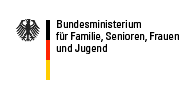Employment - Aspects
Gender perspectives in the subject area employment
- Women continue to be less often employed than men overall, but their integration into the employment market has significantly improved in the shift from the industrial society to the service society. Gains in employment relate predominantly, however, to the increased participation of women from West Germany in the employment market, which mainly comes from part-time work and low-paid jobs. With regard to unemployment, too, there are clear differences between men and women, but also with regard to origin and age. Persons without German citizenship are significantly less well integrated into the employment market than the comparison group with German passports.
- Women are still mainly responsible for unpaid work in private households. Employed women are subjected to a double or even multiple burden because of their predominant responsibility for household and domestic provision work.
- There continues to be a separation of “female careers” and “male careers”. A disproportionate number of women and men can be discerned in certain careers and industries.
- Hours of work vary greatly according to sex. This comes from the fact that women are forced to undertake the main burden of housework and domestic provision and therefore (at least temporarily) reduce their hours of work. While women more frequently take part-time or low-paid work, most men work full-time. Overtime is also disproportionately worked by men.
- There continues to be a significant income gap between men and women, which, combined with reduced hours of work, have a negative impact for women by virtue of correspondingly lower social security benefits in old age or if they are unemployed by virtue of receiving less unemployment benefit. This income gap, it must be said, it far more pronounced in the private sector than in the civil service.
- There are significantly fewer women in the higher echelons of politics, administration, industry and science. This phenomenon is known as the “glass ceiling” since women are only represented up to a certain level in the hierarchy. This situation is a clear expression of existing inequalities in working life.
- Women and men are differently affected by regulation of employment by active employment market policies. A de facto inequality between women and men can lurk behind apparently gender neutral rules. Typical examples in this connection include different target marks in quotas for job placements and appointments or in differentiating by gender in the assigning of duties. Some tools, e.g. the promotion on mini-jobs, seem moreover to reinforce existing gender inequalities and give impetus to deprofessionalisation tendencies. By expanding the low wage sector, in particular in people-related services, certain quality standards applicable in paid employment, such as professional qualifications, carry little weight. This contributes to a cementing of the gender-specific structure of the employment market.
Further reading:
- European Foundation for the Improvement of Living and Working Conditions: Working conditions and gender in an enlarged Europe, 2005.
- European Commission: Website on women and men in decision-making.
- European Commission: Report on equality between women and men, 2004.
- European Commission: Technical Paper 3: Mainstreaming Equal Opportunities For Women And Men In Structural Fund Programmes And Projects, Luxemburg 2000.
- FOCUS – Fostering Caring Masculinities, a research project initiated by the Norwegian Ministry of Children and Equality, including five country studies on Germany, Iceland, Norway, Slovenia and Spain and a transnational report:
- Langvasbråten, Trude / Teigen, Mari: FOCUS - The European Dimension, Oslo 2006.
- Gärtner, Marc / Gieseke, Jonas / Beier, Stefan: Fostering Caring Masculinities (FOCUS) - German National Report, Berlin 2006.
Including qualitative research in an internationally operating energy company and in the Federal Environment Agency (Umweltbundesamt).
- Stiegler, Barbara: Gender in Relation - Ideas for Gender Mainstreaming Processes, Center for Economic and Social Policy Research, Friedrich-Ebert-Stiftung, 2005, especially chapter 2.2 Strategies to counter the sexual division of the labor market (p.18-20).
- Bundesministerium für Familie, Senioren, Frauen und Jugend: 1. Datenreport zur Gleichstellung von Frauen und Männern in der Bundesrepublik Deutschland – Kapitel 2: Erwerbstätigkeit – Arbeitsmarktintegration von Frauen und Männern, erstellt vom Deutschen Jugendinstitut in Kooperation mit dem Statistischen Bundesamt, Berlin 2005.
- Bundesministerium für Familie, Senioren, Frauen und Jugend: 1. Datenreport zur Gleichstellung von Frauen und Männern in der Bundesrepublik Deutschland – Kapitel 3: Erwerbseinkommen von Frauen und Männern, erstellt vom Deutschen Jugendinstitut in Kooperation mit dem Statistischen Bundesamt, Berlin 2005.
- BMFSFJ: Zur Berufs- und Einkommenssituation von Frauen und Männern, Berlin 2001.
- BMFSFJ / Zentralverband des deutschen Handwerks (Ed.): Familienfreundliche Maßnahmen im Handwerk - Potenziale, Kosten-Nutzen-Relationen, Best Practices, Berlin 2004.
- Baur, Christine / Fleischer, Eva / Schober, Paul: Gender Mainstreaming in der Arbeitswelt - Grundlagenwissen für Projekte, Unternehmen und Politik, Innsbruck 2005.
- Bundesagentur für Arbeit: Entwicklung der Chancengleichheit von Frauen und Männern am Arbeitsmarkt, 2005.
- Krabel, Jens / Stuve, Olaf (Ed.): Männer in "Frauen-Berufen" der Pflege und Erziehung, Leverkusen-Opladen: Barbara Budrich 2005.
- Gesterkamp, Thomas: Im Spagat zwischen Beruf und Familie. Werbung für die "Väterzeit". Das Parlament, Nr. 19 - 20/2002.
erstellt von Administrator
—
zuletzt verändert:
02.01.2010 20:07






